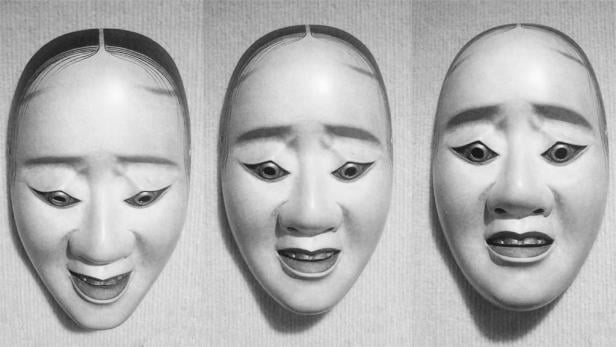
Anonymous: The Dilemma of the Mask
Dieser Artikel ist älter als ein Jahr!
The beauty of the mask is that you can never really know who is wearing it. We might think of the "Thomas Crown Affair", in which a witty diversion is created by the choreography of men dressed in suits and bowler hats in echo of René Magritte’s signature motif, which lifts the mundane into the surreal. Similarly, the V-mask converts the ordinary into the extraordinary, and yet at the same time removes any chance of actually locating those behind the name Anonymous.
A mask is of course much more than a means of deception. It is an object of transformation, which like the ventriloquist’s dummy can yield a profound power to disrupt and reconfigure. In theatre, there is a revered tradition of ‘working the mask’, with one actor passing down to another the art of handling the emotions and revelations that it brings to life.
The mask in theatre
In the "Phantom of the Opera", the mask, synonymous with the tormented and mysterious figure, shields a deep sensitivity. In "Amadeus", a masked figure evokes the spectre of Mozart’s late father, which leads to the composer writing a requiem mass and ultimately to his own death. In traditional Japanese Noh theatre, the mask dates back as far as the 14th century. The Noh mask typically has a spare aesthetic design, through which actors attempt to evoke a complex quality of grace, melancholy and the sensual, referred to in the Japanese as "yugen".

© Wikimedia Commons/Wmpearl
Despite the Noh mask appearing expressionless, it possesses a lifelike changeability that comes through its movement. In a similar way to the Anonymous V-mask, the three dimensional molding of the Noh mask exaggerates features, particularly the contours of the mouth. As the mask tilts, these contours appear to shift in the available light, making a "Mona Lisa" smile drift into a loud grin or down into a snarl and vice versa. A mask is an uncanny sight.
Batman and Zorro
The Anonymous mask actually has a more direct affiliation with the iconography of comics and cult films and television. Superheroes such as Batman and Zorro are masked crusaders who seek to uphold justice for those least able to defend themselves. In both cases, these vigilantes don a mask in order to protect their true identities. And in both cases, the mask appears to endow them with superhuman skills.
As is well-known, the origin of the Anonymous mask can be traced directly to V for Vendetta – a comic series first published in the 1980s. Its design took inspiration from the cheap, plastic masks of Guy Fawkes worn by children, which were sold in the 1980s in England as part of the annual celebration to mark the foiled Gunpowder Plot of a group of dissidents in 1605. Ironically, however, Anonymous protestors have adopted the same mask produced for the merchandise of the Time-Warner film adaption of "V for Vendetta".
Like the anti-globalisation movement of the late 1990s – as portrayed in Naomi Klein’s bestselling book "No Logo" – there is a deliberate irony adopted by groups such as Anonymous, which appropriate the modality of a spectacle politics and the illusions of consumerism. It is a confrontational response to a circular, endemic problem. In 1988, Guy Debord - one of the founders of the International Situationists - described how in our present context no mainstream political party is willing to undermine the economic status quo of capitalist consumer culture. In contemporary Europe, he writes, "no party (...) even tries to pretend they wish to change anything significant. The commodity is beyond criticism".
Masked protest
Today, a series of networked, non-hierarchical affiliations exist between and indeed within protest groups around the world. Masked protestors - whether officially part of Anonymous or not - show up at all number of street demonstrations under the banner of Occupy or those against ACTA and SOPA. In Hardt and Negri’s book "Empire", such groups equate to the idea of an autonomously constructed `counter-Empire`, as alternative political organizations undermining existing power structures.
As political theory, the book has been highly successful in defining a central problem about the perceived distance between ordinary people and global, networked systems of power. The book arguably prescribes a state of perpetual revolution, since to assert any kind of order is only to impose a new authority and sovereignty. Counter-Empire seemingly defines a form of change, but stops short of any kind of content. In this way, it is not surprising that recent protest movements such as Occupy and Anonymous seek to make a virtue out of not making demands or seeking political authority.

© Stefano Rellandini, Reuters
In "V for Vendetta" the mask represents an idea, the quasi-Hegelian notion that while people might be crushed or censored, ideas are unstoppable. The dilemma for Occupy is that it becomes a mere „occupation" of perpetual revolution; in other words a form of work or even servitude to the Idea of Occupy. Similarly, Anonymous is an exercise in foregrounding power, but makes little if any gesture towards building anything new.
The Outraged
Many in Occupy cite inspiration from the so-called `indignados` (meaning „outraged"), who amassed in Madrid and other cities across Spain in May 2011, expressing their fury at the Nation`s debt-crisis and austerity measures. Outrage describes a powerful emotion and action. Yet, we struggle to find a suitable form of engagement beyond its immediate expression. Outrage appears to have been transposed into the occupation and the anonymous taunting of the technologies of networked power. But what does it mean to have reached the point when we can only engage in politics from behind an ironic mask?
Arguably, while recent protests stem from genuine outrage, they all too often result only in incidents of outage, with the temporary short circuiting of political and economic structures. While Anonymous represents a politically powerful Idea, the dilemma is that their actions only replace one anonymity with another. We trade the faceless, unapproachable banks and corporations for an equally unknowable consortium of technology savvy activists.
Sunil Manghani is Reader in Critical and Cultural Theory at Winchester School of Art, University of Southampton (UK). He is author of "Image Critique and the Fall of the Berlin Wall" and “Image Studies: Theory and Practice”.



Kommentare